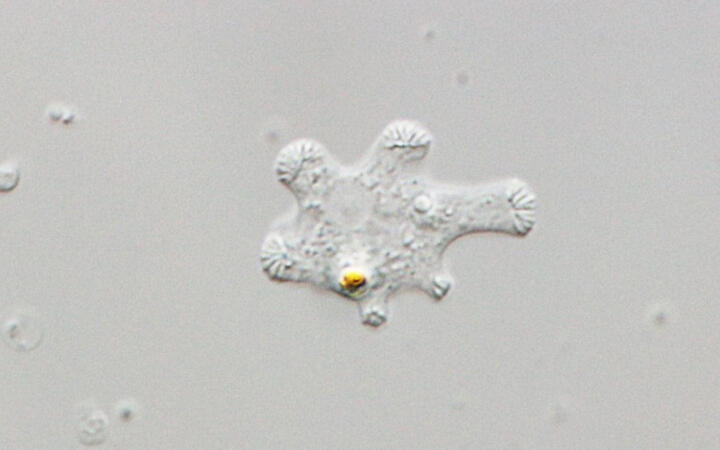Assistant Professor Takashi Shiratori and his colleagues at the Institute of Life and Environmental Sciences of the University of Tsukuba have rediscovered the rare marine amoeba Rhabdamoeba marina, of which only two discoveries have been reported in the past 100 years. After culturing this enigmatic amoeba and analyzing its genetic sequence, the researchers revealed its phylogenetic position for the first time and proposed a new taxonomic classification for it based on the results of this analysis. The results were published in The Journal of Eukaryotic Microbiology.

Provided by the University of Tsukuba
R. marina, a small marine amoeba, was discovered and described in England in 1921 and only rediscovered in 1998. It has unique features not found in other amoebae, such as a flattened pseudopodial tip with a rod-like structure. Moreover, the amoeboid cells are flagellated, with two flagella sprouting and extending backward when the surrounding food supply is low. For this reason, they had been treated as amoebae of unknown taxonomic affiliation, as it was difficult to classify them into specific taxonomic groups. Additionally, only two discoveries of this amoeba have been reported (including the original description).
The research group successfully established a culture strain of the small amoeba (SRT404) from seawater collected from Tomari Port in Tottori Prefecture in 2014. Optical microscopy revealed that SRT404 was nearly immobile and had multiple flattened pseudopodia with a rod-like structure at the tip. Flagellated cells with two flagella extending backwards were observed, leading to the conclusion that they were R. marina. Electron microscopic observations revealed for the first time a structure called a rod-shaped extrusome at the tip of the pseudopodia.Molecular phylogenetic analysis of the SRT404 ribosomal RNA gene sequence revealed that R. marina does not belong to the order Marimonadida (class Imbricatea, phylum Cercozoa), to which it was previously assigned. Instead, it is a basal lineage branching from the group Chlorarachnea, which also belongs to the Cercozoa. Based on these results, the research group proposed to classify R. marina as a species of the Chlorarachnea.
The Chlorarachnea includes two groups: the photosynthetic chlorarachniophytes, and the bacterial predatory flagellates of the genus Minorisa. However, R. marina differs from them in that it is known to prey on a variety of eukaryotic algae and heterotrophic protists. Chlorarachniophytes are a group that acquired chloroplasts by means of secondary endosymbiosis (a process in which green algae are engulfed into the cell), and their ancestors are speculated to have been predators of algae such as R. marina. Therefore, R. marina is an important organism for inferring the evolution of this group.
For the first time, the phylogenetic position of R. marina has been determined, allowing the research group to propose a new taxonomic classification for this rare and elusive amoeba. There are many known unicellular organisms whose phylogenetic positions are unknown because of limited examples of such studies. Rediscovering these unicellular organisms through careful observation of environmental samples is essential for understanding microbial diversity.
This article has been translated by JST with permission from The Science News Ltd. (https://sci-news.co.jp/). Unauthorized reproduction of the article and photographs is prohibited.




